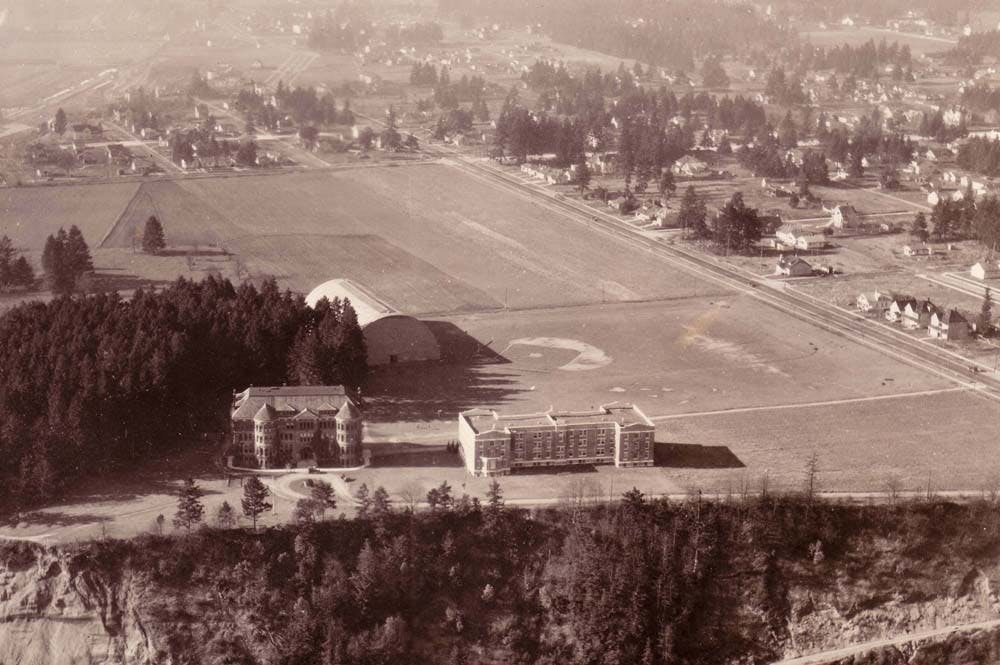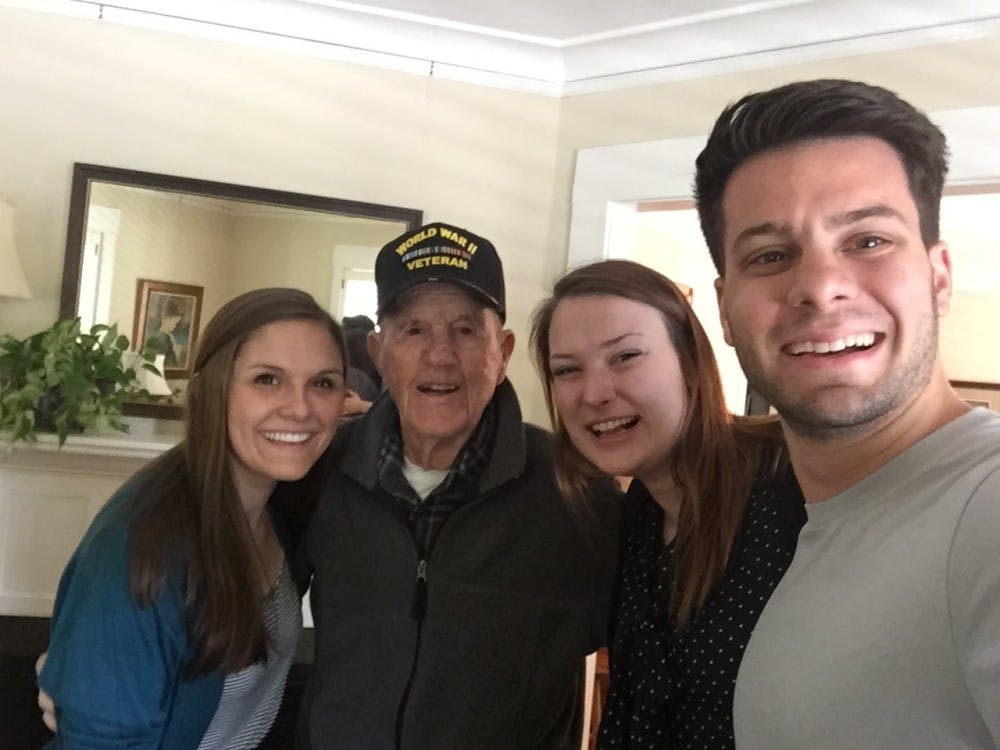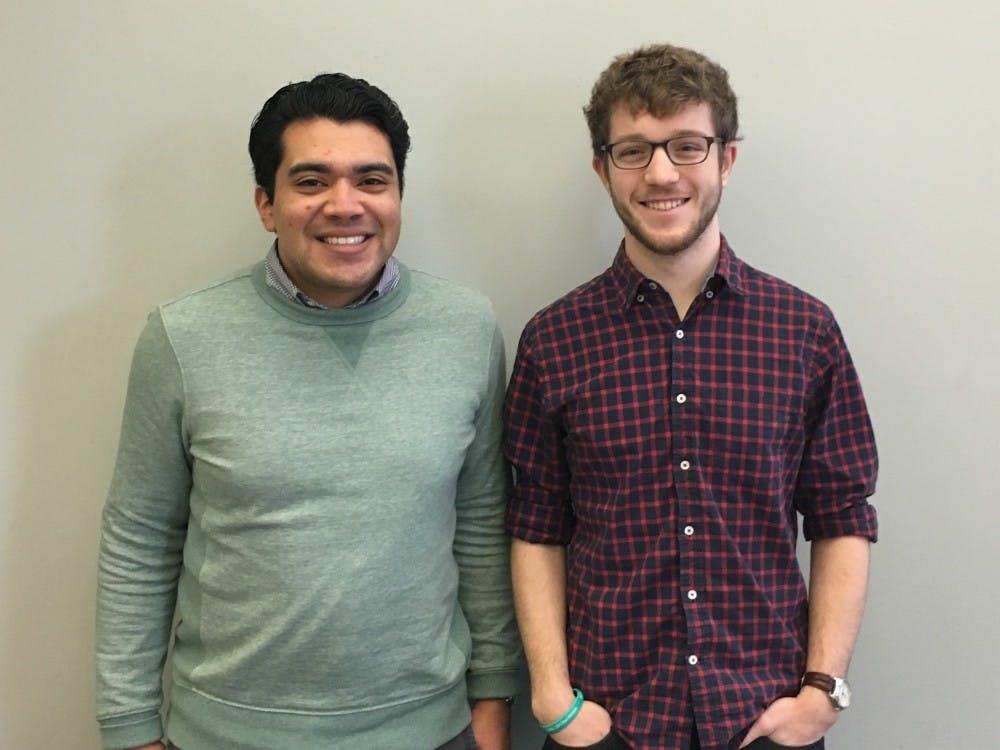1914 (Photo courtesy of Fr. Bob Antonelli, C.S.C)
By Jim Haines, Guest Commentary -- The Beacon
1901 – Columbia University is founded by Alexander Christie, archbishop of Portland, and a year later the Congregation of Holy Cross is asked to take over. The school then consisted of West Hall (renamed Waldschmidt Hall in 1992), Christie Hall, Howard Hall and a number of support facilities now long gone. Ivy was planted around the buildings for an "Ivy League" look, but was later removed as the roots of the invasive vine were found doing extensive damage to the brick façade.
1914 – A local neighborhood group plants Big-Leaf Maples along both sides of Willamette Boulevard.
1933 – Brother Ferdinand Moser, C.S.C., arrives on campus as a math and mechanical engineering instructor and an avid gardener. He nurtures many cuttings donated by individuals from around the region and along with the many seedlings he digs up himself, plants these throughout the early campus grounds. This is the source of many conifers such as redwoods, firs and pines, and the many and various broadleaf evergreens you see today. Besides hybridizing many of his own rhododendrons, he planted more than 65 varieties of the Japanese Camellia, many donated by the Oregon Camellia Society.
By 1935 – The campus totals some 80 acres, including a 35-acre farm with chickens, a dairy, orchards and vegetable crops, all destined for the student dining halls. The school changes its name to the University of Portland.
1939 – The farm is discontinued and dismantled, and grass fields sown in its stead.
1944 – The Oregon Camellia Society donates plant material and designates the campus a repository for its camellias.
1945 – Fr. John Molter, C.S.C., arrives on campus as a science teacher. He was an avid gardener and maintained several plots of vegetables around campus.
1948 – Br. Godfrey Vasallo, C.S.C., obtains a large rock and has a plaque mounted on it commemorating the Lewis and Clark Expedition. It endures today in a grove of trees near the Captain Clark Monument behind Swindells Hall.
Also in 1948 – The Praying Hands Memorial is erected honoring the University students who died in service during World War II. The Memorial has since been expanded to include World War I, The Korean War, the War in Vietnam and the Gulf War. It is now collectively known as the Broken Wall Memorial, commemorating those who served their country with the greatest sacrifice.
1950's – Bro. Remy Aydt continues to plant out the cuttings and seedlings growing in a nursery area where the Shiley Hall addition now stands.
1962 – Many of the original Doug Firs on campus are lost in the infamous Columbus Day storm. During this period more are lost to disease and construction. Most open areas are reseeded into turf.
1963 – The Commons is completed and an extensive rock garden is built on the south side overlooking a plaza paved with Italian marble. A recent addition includes a small alpine garden in honor of Lewis and Clark.
1964 – Ted ‘Gottleib' Deiss becomes head groundskeeper. He was trained in Switzerland, landscaped extensively in the U.S. including a stint at our nation's capitol. Ted owned and operated a 19-greenhouse complex in Beaverton. He grew vegetables for Portland's fresh produce market. On his appointment by Fr. Paul Waldschmidt, C.S.C., Ted donates and sets up a then-state-of-the-art greenhouse where the Villa Basketball Court now sits. He retired in 1977.
1965 – The old farm well is re-drilled by the Army Corps of Engineers to a depth of 245 feet. The Corps donates a large variable speed well-pump, which still serves all of the University's irrigation needs. It's located in a below-ground vault adjacent the west corner of Buckley Center. The irrigation main-line loop is started, and rudimentary above-ground watering systems are installed. Due to heavy damage inflicted by a severe winter ice storm, the Big-Leaf Maples along Willamette Boulevard undergo extensive remedial pruning. Replacement of these trees begins.
1966 – Shipstad Hall is completed and the unique use of Atlas Cedars as a vertical wall planting is started.
1968 – Buckley Center is completed, and an extensive landscape of azaleas, rhododendrons and pines is planted around the new building by Master Gardener Tatsu "Dutch" Watanabe.
1973 – Mago Hunt Center for the Performing Arts is completed and several varieties of dogwood, crabapple and flowering plum, along with azaleas and rhododendrons, are used in the landscape.
1980 – Lowell Cordas, a skilled horticulturist, assumes the role as Head Groundskeeper. His talents in landscape design enhance the work of earlier gardeners. He sets new standards, bringing widespread recognition to the campus garden the community enjoys today.
1982 – The William Ingram Estate of Salem donates many mature camellias to the University, including several "C. sasanqua," which can be seen blooming from early winter through early spring along the east side of Howard Hall and the west side of the Louisiana Pacific Tennis Center.
1984 – The Chiles Center is completed, and an extensive species rhododendron garden is planted between the buttresses under Japanese Styrax (snowbell) trees. Native to Nepal, Tibet, and western China, these plants were dug and transplanted from several regional nurseries by members of the Grounds Crew.
1985 – Professor Manual ‘Manny' Macias donates a 14-foot traditional Spanish O' Cruceiro sculpture in honor of his parents. It stands among the lofty redwoods between The Library and Buckley Center.
1987 – The Captain William Clark Monument, designed and sculpted by Michael Florin Dente, is erected and dedicated. It is landscaped with plants similar to what would have been present at the time of the party's visit.
1997 – Several large trees, including Sequoias, Incense Cedars and a Douglas Fir are cut down to make the necessary room for the Interactive Science Lab Building later dedicated as Swindells Hall. A portable mill operation is hired to salvage and recycle lumber.
2000 – University Village's Tyson and Haggerty residence halls are dedicated and open for business. An extensive landscape of Incense-Cedar, Flowering Cherry, several varieties of Magnolia, rhododendrons and ornamental grasses fill the spaces around the buildings.
2001 – A large brush fire roars along the Willamette Bluff, killing many trees and stripping the slopes in several places. The Grounds Crew, with help from the City's Bureau of Environmental Services, begins a long-term restoration project aimed at reducing wildfire fuel loads and restoring the woodlands along the river to the native Oak-Savanna habitat. This entails the removal of the non-native and invasive plants and replanting of desirable species such as native grasses, currants, native berries, manzanita, ferns, wild roses, salal and our state flower, the Oregon grape. Trees such as madrones, native conifers and the Oregon white oak, Quercus garryana are planted.
– submitted by Jim Haines
Wren Weichman








